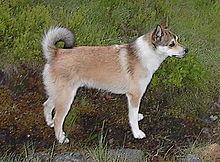Lundehund

A Norwegian Lundehund
|
||||||||||||||
| Other names |
|
|||||||||||||
|---|---|---|---|---|---|---|---|---|---|---|---|---|---|---|
| Common nicknames | Lundehund | |||||||||||||
| Origin | Norway | |||||||||||||
|
||||||||||||||
|
||||||||||||||
| Domestic dog (Canis lupus familiaris) | ||||||||||||||
| Traits | |||
|---|---|---|---|
| Weight | 6–7 kilograms (13–15 lb) | ||
| Height | 30–40 centimetres (12–16 in) | ||
| Classification / standards | |||
|---|---|---|---|
| FCI | Group 5, Section 2 Nordic Hunting Dogs #265 | standard | |
| AKC | Non-Sporting | standard | |
| UKC | Northern Breed | standard | |
The Norwegian Lundehund (Norsk Lundehund) is a small dog breed of the Spitz type that originates from Norway. Its name is a compound noun composed of the elements Lunde, meaning puffin (Norwegian lunde "puffin" or lundefugl "puffin bird"), and hund, meaning dog. The breed was originally developed for the hunting of puffins and their eggs.
The Norwegian Lundehund is a small, rectangular Spitz type dog. The Lundehund has a great range of motion in its joints, allowing it to fit into and extricate itself from narrow passages. Dogs of this breed are able to bend their head backwards along their own spine and turn their forelegs to the side at a 90-degree horizontal angle to their body, much like human arms. Their pricked, upright ears can be folded shut to form a near-tight seal by folding forward or backward. The Norwegian Lundehund is a polydactyl: instead of the normal four toes per foot, the Lundehund normally has six toes, all fully formed, jointed and muscled. Some specimens may on occasion have more or fewer than six toes per foot, but this is then outside the breed standard. The outercoat is dense and rough with a soft undercoat. The Lundehund is adapted to climb narrow cliff paths in Værøy where it originally would have hunted puffins. Some general information can be found on the Norwegian Lundehund Association webpages
The breed has a long history. They are the most ancient of the Nordic dog breeds, scientific research indicates that the breed has been in existence since before the last Ice Age, surviving by eating fish and sea birds. It is thought that the Lundehund is actually a descendant of the primeval dog, Canis forus, rather than the domesticated dog breeds, Canis familiaris. The Lundehund was a valuable working animal, essential in hunting puffin birds along the Norwegian coast for food as well as the commercial export of puffin down from the Viking Age through the 16th and 17th centuries. Its flexibility and extra toes were ideal for hunting the birds in their inaccessible nesting locations on cliffs and in caves. Interest for the breed declined when new methods for hunting puffins were incorporated and a dog tax was created. Around 1900, they were only found in the isolated village of Mostad (spelled Måstad in Norwegian), Lofoten. The breed was nearly extinct around World War II when canine distemper struck Værøy and the surrounding islands. In 1963, the population was further decimated by another outbreak of distemper. This time, only six dogs survived, one on Værøy and five in southern Norway, Hamar. The latter five were from the same mother. This created a population bottleneck. Due to careful breeding with strict guidelines, there are now an estimated 1400 dogs in the world (2010), with around 600 of the population in Norway and ~350 in the United States.
...
Wikipedia
